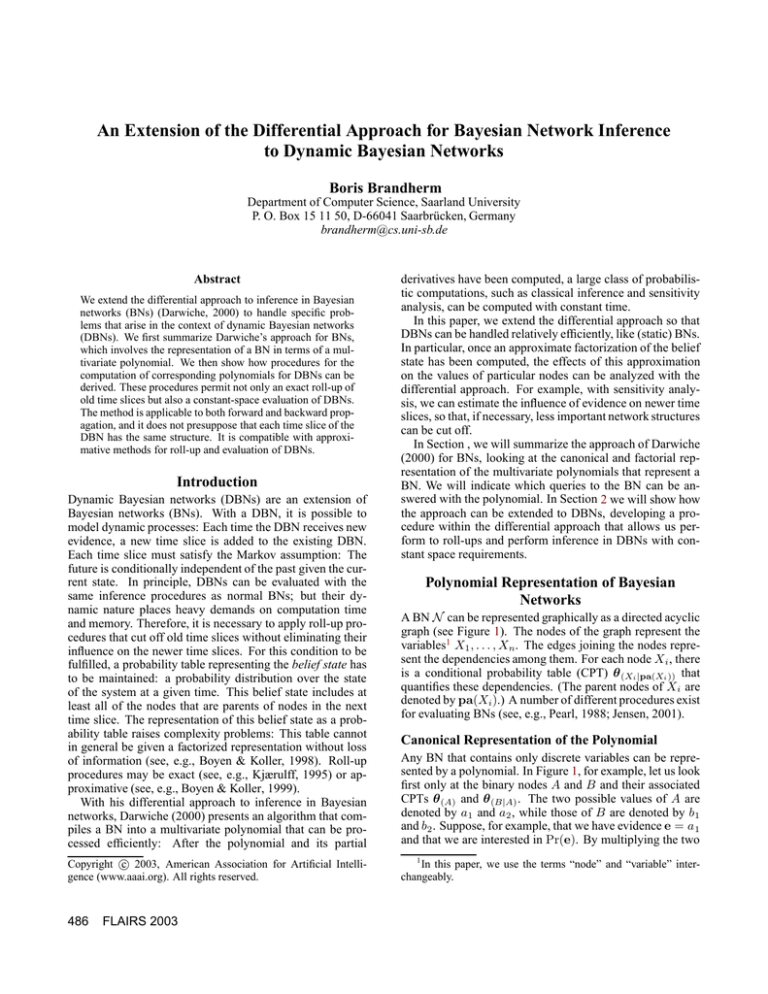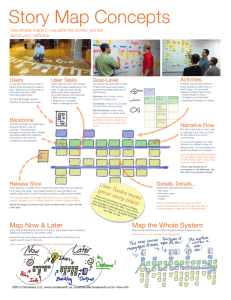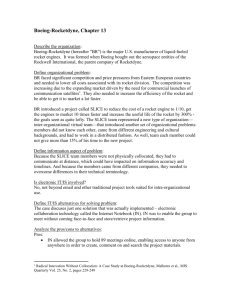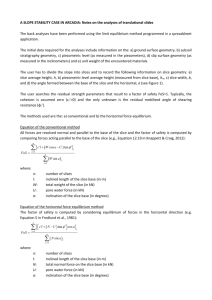
An Extension of the Differential Approach for Bayesian Network Inference
to Dynamic Bayesian Networks
Boris Brandherm
Department of Computer Science, Saarland University
P. O. Box 15 11 50, D-66041 Saarbrücken, Germany
brandherm@cs.uni-sb.de
Abstract
We extend the differential approach to inference in Bayesian
networks (BNs) (Darwiche, 2000) to handle specific problems that arise in the context of dynamic Bayesian networks
(DBNs). We first summarize Darwiche’s approach for BNs,
which involves the representation of a BN in terms of a multivariate polynomial. We then show how procedures for the
computation of corresponding polynomials for DBNs can be
derived. These procedures permit not only an exact roll-up of
old time slices but also a constant-space evaluation of DBNs.
The method is applicable to both forward and backward propagation, and it does not presuppose that each time slice of the
DBN has the same structure. It is compatible with approximative methods for roll-up and evaluation of DBNs.
Introduction
Dynamic Bayesian networks (DBNs) are an extension of
Bayesian networks (BNs). With a DBN, it is possible to
model dynamic processes: Each time the DBN receives new
evidence, a new time slice is added to the existing DBN.
Each time slice must satisfy the Markov assumption: The
future is conditionally independent of the past given the current state. In principle, DBNs can be evaluated with the
same inference procedures as normal BNs; but their dynamic nature places heavy demands on computation time
and memory. Therefore, it is necessary to apply roll-up procedures that cut off old time slices without eliminating their
influence on the newer time slices. For this condition to be
fulfilled, a probability table representing the belief state has
to be maintained: a probability distribution over the state
of the system at a given time. This belief state includes at
least all of the nodes that are parents of nodes in the next
time slice. The representation of this belief state as a probability table raises complexity problems: This table cannot
in general be given a factorized representation without loss
of information (see, e.g., Boyen & Koller, 1998). Roll-up
procedures may be exact (see, e.g., Kjærulff, 1995) or approximative (see, e.g., Boyen & Koller, 1999).
With his differential approach to inference in Bayesian
networks, Darwiche (2000) presents an algorithm that compiles a BN into a multivariate polynomial that can be processed efficiently: After the polynomial and its partial
c 2003, American Association for Artificial IntelliCopyright gence (www.aaai.org). All rights reserved.
486
FLAIRS 2003
derivatives have been computed, a large class of probabilistic computations, such as classical inference and sensitivity
analysis, can be computed with constant time.
In this paper, we extend the differential approach so that
DBNs can be handled relatively efficiently, like (static) BNs.
In particular, once an approximate factorization of the belief
state has been computed, the effects of this approximation
on the values of particular nodes can be analyzed with the
differential approach. For example, with sensitivity analysis, we can estimate the influence of evidence on newer time
slices, so that, if necessary, less important network structures
can be cut off.
In Section , we will summarize the approach of Darwiche
(2000) for BNs, looking at the canonical and factorial representation of the multivariate polynomials that represent a
BN. We will indicate which queries to the BN can be answered with the polynomial. In Section 2 we will show how
the approach can be extended to DBNs, developing a procedure within the differential approach that allows us perform to roll-ups and perform inference in DBNs with constant space requirements.
Polynomial Representation of Bayesian
Networks
A BN N can be represented graphically as a directed acyclic
graph (see Figure 1). The nodes of the graph represent the
variables1 X1 , . . . , Xn . The edges joining the nodes represent the dependencies among them. For each node Xi , there
is a conditional probability table (CPT) θ (Xi |pa(Xi )) that
quantifies these dependencies. (The parent nodes of Xi are
denoted by pa(Xi ).) A number of different procedures exist
for evaluating BNs (see, e.g., Pearl, 1988; Jensen, 2001).
Canonical Representation of the Polynomial
Any BN that contains only discrete variables can be represented by a polynomial. In Figure 1, for example, let us look
first only at the binary nodes A and B and their associated
CPTs θ(A) and θ(B|A) . The two possible values of A are
denoted by a1 and a2 , while those of B are denoted by b1
and b2 . Suppose, for example, that we have evidence e = a1
and that we are interested in Pr(e). By multiplying the two
1
In this paper, we use the terms “node” and “variable” interchangeably.
table T that contains the probabilities of the individual hypothesis combinations, that is:
A
T = Πni=1 θ (Xi |pa(Xi )) λXi .
B
C
D
Figure 1: Example of a Bayesian network with four binary
nodes [Pr(A, B, C, D) = Pr(A) ∗ Pr(B | A) ∗ Pr(C | B) ∗
Pr(D | B)]
CPTs, we obtain an overall probability table θ (A,B) that represents the joint probability distribution of the nodes A and
B:
θ(A,B) = θ (A) θ (B|A)
θ a1
θb1 |a1 θb1 |a2
θa1 θb1 |a1 θa2 θb1 |a2
= θ
= θ θ
.
θb2 |a1 θb2 |a2
θa2 θb2 |a2
a2
a1 b2 |a1
Now we need only to add up the table entries (probabilities) that are consistent with a1 , and we obtain the desired
result:
Pr(e) = θa1 θb1 |a1 + θa1 θb2 |a1 .
For each variable in the BN, it is possible that evidence
has been obtained. Such evidence can be represented by an
evidence vector λXi for the node in question. The vector
contains a 1 for the state which is realized and a 0 for each
other state of the variable. (When no evidence concerning
a given variable is available, each element of the evidence
vector is 1.)
We can use the evidence vectors to parametrize the probability table, so that it takes into account the available evidence, as follows:
Adding up all of the table entries in T, we obtain the multivariate polynomial in canonical from (see also Darwiche,
2000).
F(λXi , θ (Xi |pa(Xi )) ) = ΣX Πni=1 θ(Xi |pa(Xi )) λXi .
The size of a multivariate polynomial in canonical form is
always exponential in the number of the variables. A way of
avoiding the resulting complexity is offered by the factored
representation of the polynomial, which is discussed in the
following section.
Factored Representation of the Polynomial
In finding a factorization of the multivariate polynomial, we
want to take into account the structure of the Bayesian network; that is, we want to exploit the factored representation
of the joint probability distribution in order to reduce the
complexity of the multivariate polynomial. We will not simply compute the product of all of the CPTs with their evidence vectors. Instead, we will first find an ordering of the
nodes according to which the CPTs and their corresponding
evidence vectors λXi are to be multiplied. Early in this process, we will marginalize as many nodes as possible out of
this product, so as to obtain the multivariate polynomial in
factored instead of canonical form.
As an illustration, let us take once again the example of
the nodes A and B. Suppose that the order of processing
of the nodes is “First B, then A”. This order is also called
the elimination order π = hB, Ai. If we marginalize out the
nodes as soon as possible, we obtain:
F(λA , λB , θ(A) , θ(B|A) ) =
FhB,Ai (λA , λB , θ(A) , θ (B|A) ) =
ΣA θ(A) λA (ΣB θ (B|A) λB ) =
θ(A,B) λA λB = θ (A) λA θ(B|A) λB
λ λ
θ θ
λ λ
θ θ
= θa1 θb1 |a1 λa1 λb1 θa2 θb1 |a2 λa2 λb1 .
a2 b2 |a2 a2 b2
a1 b2 |a1 a1 b2
By adding up all of the table entries, we obtain a multivariate polynomial:
F(λA , λB , θ(A) , θ(B|A) ) =
θa1 θb1 |a1 λa1 λb1 + θa2 θb1 |a2 λa2 λb1 +
θa1 λa1 (θb1 |a1 λb1 + θb2 |a1 λb2 )+
θa2 λa2 (θb1 |a2 λb1 + θb2 |a2 λb2 ) .
When we compare the polynomial in factored form with the
polynomial in canonical form, we notice that in the factored
form there are some multiplications less that need to be computed. In connection with the notation of the elimination
order, it should be noted that the following holds:
ΠhB,Ai θ (X|pa(X)) λX = θ(A) λA θ (B|A) λB
θa1 θb2 |a1 λa1 λb2 + θa2 θb2 |a2 λa2 λb2 .
Now we can determine through the evidence vectors which
table entries are to be added up. The λxi that are consistent
with the evidence e are set to 1, while the other λxi are set
to 0. In our example, therefore, λa2 = 0 and λa1 = λb1 =
λb2 = 1.
With this polynomial, for example, we can compute the
belief for particular nodes in the network, and we can perform various sensitivity analyses. Much more detail can be
found in the articles by Darwiche.
In general, the multivariate polynomial is computed as
follows: First we multiply all of the CPTs of the nodes of
the BN together with their evidence vectors λXi to obtain a
and
ΣhB,Ai θ(A) λA θ (B|A) λB =
ΣhAi ΣhBi θ(A) λA θ(B|A) λB =
ΣA θ(A) λA (ΣB θ(B|A) λB ).
We will use the following abbreviated notation for the
multivariate polynomial in factored form:
Felim({X∈N }) (λX , θ(X|pa(X)) ) =
Σelim({X∈N }) Πelim({X∈N }) (θ(X|pa(X)) λX ) =
ΣhX1 ,...,Xn i ΠhX1 ,...,Xn i (θ(X|pa(X)) λX ) .
FLAIRS 2003
487
A
A
A
B
B
B
C
D
C
Time Slice 1
D
Time Slice 2
C
D
Time Slice 3
Figure 2: Example dynamic Bayesian network discussed in
the text [ Pr(A1 , B1 , . . .) = Pr(A1 ) ∗ Pr(B1 | A1 ) ∗ . . . ]
Here, elim({X ∈ N }) is a function that computes the elimination order of the variables.2
Computation of the Polynomial in DBNs
Now we will see how these ideas of Darwiche (2000) can
be extended and applied to DBNs. Let us look at the DBN
in Figure 2, which at this point comprises three time slices.
This DBN includes two building blocks (so-called time slice
schemas), shown in Figure 3. The first schema, used for the
first time slice, is simply a BN. The second schema, which
is used for each of the remaining time slices, is a BN plus
a specification of the parent variables that are taken from
the preceding time slice. Suppose that we have evidence
e = e1 , . . . , e3 for Time Slices 1 through 3 and that we
want to know the belief vector for a node in Time Slice 2—
i.e., the vector that expresses how likely each possible value
of the variable is, given the currently available evidence.
We now have to distinguish between (a) forward propagation, which brings forward the impact of the evidence from
Time Slice 1 to Time Slice 2; and (b) backward propagation,
which brings the impact of evidence from Time Slice 3 back
to Time Slice 2.
In the following we will define procedures that will allow us to determine the beliefs for nodes in an arbitrary time
slice t (with 1 ≤ t ≤ L); to cut off old time slices; and to
add new time slices. These computations can be performed
in constant space (depending on the structure of the time
slice schemas). We perform a roll-up by assigning values
to the variables of the polynomial and then simplifying the
polynomial by evaluating it. We add new time slices efficiently by recycling polynomials and computations from the
preceding time slices.
Typically, we will not use a single arbitrary elimination
order for the whole DBN; instead we will use an elimination
order that is restricted to one time slice. In this way, we
will obtain for each time slice schema a general procedure
for the partial polynomial that corresponds to this time slice
schema.
Forward Propagation
First, we will look at the case of forward propagation. To
simplify exposition, we assume that we have only one time
2
The question of which such function is to be used does not
concern us here; cf Kjærulff (1995).
488
FLAIRS 2003
C
A
A−1
A
B
B−1
B
D
C
D
Figure 3: Time Slice Schemas 1 and 2 for the dynamic
Bayesian network shown in Figure 2
slice schema available for the instantiation of the initial time
slice, and also only one time slice schema for the instantiation of the following time slices, as in our example DBN.
Later, we will sketch how it is possible to generalize the
procedure to deal with an arbitrary number of time slice
schemas for the instantiation of the initial and the succeeding time slices.
For the first time slice, we will determine a procedure that
permits a simple and efficient extension of the old polynomial when a new time slice is added to the DBN. Let us look
at Time Slices 1 and 2 in Figure 2. We can see that in Time
Slice 1 the parent nodes of nodes in Time Slice 2 cannot be
marginalized out until Time Slice 2 has been added. The result of the procedure for the first time slice is a table over the
nodes of the current time slice that could not be marginalized
out. Because only one time slice schema can be instantiated
for the following time slices, we know which nodes in the
current time slice will become parent nodes of nodes in the
following time slices, and we can determine the nodes that
belong to the belief state. (The set of these nodes is denoted
by bs(.).) In our example, these are the nodes A1 and B1 ,
so bs(1) = {A1 , B1 }. The indices in the nodes denote the
time slice to which they belong.
In our example DBN, we obtain as a procedure for forward propagation for the first time slice:
fwdinit = θ(A1 ) λA1 θ (B1 |A1 ) λB1
(ΣC1 θ(C1 |B1 ) λC1 ) (ΣD1 θ (D1 |B1 ) λD1 ) .
As was already mentioned, the result is a table over the
Cartesian product of the hypotheses of the nodes A1 and
B1 , that is fwdinit = T(A1 B1 ) . The table entries of T(A1 B1 )
itself are polynomials. We obtain the polynomial for the first
time slice by summing over all of these table entries, that is
over all of the nodes that have been left out so far. With this
polynomial, it is possible, for example, to compute the belief value of a node. In T(A1 B1 ) , on the other hand, all of the
information is contained that must be passed to a later time
slice so as to permit exact inference. As yet no evidence
has been instantiated in the polynomial or in T(A1 B1 ) . To
simplify the polynomial or T(A1 B1 ) , all of the λxi of the
noninteresting nodes can be set to the given evidence or to 1
if no evidence is given.
Now let us look at Time Slice 2 with its predecessor Time
Slice 1 and its successor Time Slice 3 in Figure 2. We want
to determine a procedure which takes into account the effects of the earlier time slice on the following time slices
and which allows a simple and efficient extension of the old
polynomial when a new time slice is added.
As was the case with the procedure for the first time slice,
the nodes of the belief state cannot be marginalized out until
the following time slice has been added. In our example, the
nodes in question are A2 and B2 .
We obtain the following as a procedure for forward propagation in the second time slice in our example in Figure 2:
fwd2 (T(A1 B1 ) ) =
(ΣC2 θ (C2 |B2 ) λC2 ) (ΣD2 θ (D2 |B2 ) λD2 )
(ΣA1 θ(A2 |A1 ) λA2 (ΣB1 θ(B2 |A2 ,A1 ,B1 ) λB2
T(A1 B1 ) )) = T(A2 B2 ) .
It is easy to see that the procedures for the following time
slices are all identical and that the procedures for the time
slices i (with i ≥ 1) can be generalized to:
fwdi (T(Ai−1 Bi−1 ) ) =
(ΣCi θ(Ci |Bi ) λCi ) (ΣDi θ (Di |Bi ) λDi )
(ΣAi−1 θ (Ai |Ai−1 ) λAi (ΣBi−1 θ (Bi |Ai ,Ai−1 ,Bi−1 ) λBi
T(Ai−1 Bi−1 ) )) = T(Ai Bi ) .
In the case where i = 1, the variables with the index 0 disappear, and we have:
fwd1 (T(A0 B0 ) ) = fwd1 (1).
The polynomial for Time Slices 1 through L is as follows:
Felim({X∈N }) (λXi , θ (Xi |pa(Xi )) ) =
Σelim({AL ,BL }) (fwdL (. . . fwd2 (fwd1 (1)) . . .)) =
Σelim({AL ,BL }) (fwdL ◦ . . . ◦ fwd2 ◦ fwd1 (1)) .
Before we show how the polynomial can be evaluated with
constant space requirements, we want to capture the results
obtained so far in a general notation. As a general procedure
for forward propagation from the first time slice, we obtain:
fwdinit = Σelim({X|X∈TS(1)\bs(1)})
ΠX∈TS(1) θ(X|pa(X)) λX =
Σelim({X|X∈TS(1)\bs(1)})
ΠX∈TS(1) θ(X|pa(X)) λX 1 = fwd1 (1) .
TS(1) denotes the nodes of the first time slice, and bs(1)
denotes the set of nodes that belong to the belief state of the
first time slice. To simplify exposition (especially for the
algorithm in the next column) we have introduced here the
notation fwd1 (1) for fwdinit .
The polynomial for the first time slice is therefore as follows:
Felim({X∈N }) (λXi , θ(Xi |pa(Xi )) ) =
Σelim(bs(1)) (fwdinit ) =
Σelim(bs(1)) (fwd1 (1)) =
Σelim(bs(1)) (Σelim({X|X∈TS(1)\bs(1)})
ΠX∈TS(1) θ (X|pa(X)) λX 1) .
Now let us look at the case in which a time slice is to be
added to the existing DBN. The situation is different from
the one for the first time slice: To the general procedure for
the i-th time slice is now passed on the table over all nodes
that were not marginalized out by the procedure that was just
applied:
fwdi (T) = Σelim({X|X∈TS(i)\bs(i)})
Σelim({X|X∈bs(i−1)})
ΠX∈TS(i) θ(X|pa(X)) λX T .
T is a table over the set of nodes {X | X ∈ bs(i − 1)},
which in general was computed by the procedure of the preceding time slice. The result of the function fwd i is a table
over the set of nodes {X | X ∈ bs(i)}.
The polynomial for Time Slices 1 through L is as follows:
Felim({X∈N }) (λXi , θ(Xi |pa(Xi )) ) =
Σelim(bs(L)) (fwdL (. . . fwd2 (fwd1 (1)) . . .)) =
Σelim(bs(L)) (fwdL ◦ . . . ◦ fwd2 ◦ fwd1 (1)) .
The evaluation of the polynomial with constant space requirements for the time slice L is obtained as follows:
1. T = 1;
2. For i = 1 to L:
Tnew = fwdi (T); T = Tnew ;
3. F(e1 , . . . , eL ) = Σelim(bs(L)) (T);
In Step 1, for the initial time slice, the value 1 is passed on
to the table T. In Step 2, a loop is traversed with the index
running from 1 to L. In the first iteration, a new table Tnew is
computed by the initial time slice, that is Tnew = fwd1 (1).
In the i-th iteration, Tnew = fwdi (T ) is computed, which
takes into account the effects of the earlier time slice. In
the computation within the loop, already existing variables
are reused efficiently. In particular, for the determination of
fwdi (T), the corresponding general procedures are applied.
Consequently, in a subsequent pass through the loop, no further memory allocation is performed if all evidence vectors
of the current time slice have been given numerical values.
Finally, in step 3 the polynomial is computed.
The polynomial F(e1 , . . . , eL ) can be used for the computation of the belief values of the nodes in time slice t, as
well as for other computations, such as sensitivity analyses,
as was mentioned briefly in Section 1 and as is discussed in
more detail by Darwiche (2000).
The procedure can also be generalized to DBNs in which
more than one time slice schema is available for the instantiation of each time slice. A directed graph can be used to
model the dependencies among the time slice schemas that
determine in which orders they can be instantiated, so that
the number of procedures can be minimized. In Figure 4 the
solid lines indicate the directed graph that models the dependencies among the time slice schemas (see Figure 3) for
the example DBN (see Figure 2). The whole directed graph
(with dashed and solid lines) in Figure 4 comprises two time
slice schemas (Time Slice Schema 1 and Time Slice Schema
3) that can be instantiated as the initial time slice of the DBN
and two other time slice schemas (Time Slice Schema 2 and
Time Slice Schema 4) that can be instantiated as following
time slices of the DBN. After Time Slice Schema 1, either
FLAIRS 2003
489
Time Slice
Schema 1
Time Slice
Schema 2
Time Slice
Schema 3
Time Slice
Schema 4
Figure 4: Directed graph that determines in which orders the
time slice schemas can be instantiated
Time Slice Schema 2 or Time Slice Schema 4 can be instantiated as the following time slice. After Time Slice Schema
3, only Time Slice Schema 4 can be instantiated as the following time slice.
The procedures can be adapted so that we do not have
to compute the table T, which passes on all information
without approximation. Instead, several smaller tables can
be computed which are much less complex than the overall
table T and whose product approximates the overall table.
Boyen and Koller (1999) describe how the overall table can
be split up into smaller tables with minimal loss of information.
Backward Propagation and Combined Forward
and Backward Propagation
As was the case with forward propagation, general procedures for backward propagation can be determined that pass
the effects of evidence from newer time slices on to older
time slices.
If we are interested in the belief values of nodes in time
slice t of a DBN from the Time Slices 1 through L (with
1 ≤ t ≤ L), we can combine the procedures for forward
and backward propagation: We multiply the procedures for
the polynomial for forward propagation from Time Slice 1
through t with the procedures for the polynomial for backward propagation from Time Slices L through t + 1. Then
we marginalize out the nodes bs(t).
The evaluation of the polynomial with constant space requirements for the time slice t is obtained as follows:
1. F = 1;
2. For i = 1 to t:
Fnew = fwdi (F);
3. B = 1;
F = Fnew ;
4. For i = L downto t + 1:
Bnew = bwdi (B); B = Bnew ;
5. F(e1 , . . . , et , . . . , eL ) = Σelim(bs(t)) (F ∗ B);
Here the same remarks hold as for the preceding algorithm. We now call the table F in the case of forward propagation und B in the case of backward propagation.
Summary
We have shown how the differential approach to the evaluation of Bayesian networks (see Darwiche, 2000) can be
extended to dynamic Bayesian networks. We have specified
the procedures that can be used to determine the relevant
490
FLAIRS 2003
polynomials for arbitrarily large DBNs. Computations for
partial polynomials can be reused.
Through the use of these formulas, we can perform forward and backward propagation (including the combination
of the two). We can also roll up older time slices and
other superfluous network structures while ensuring constant space requirements in the evaluation of the polynomials.
The other advantages of the differential approach are now
also available for DBNs, for example, efficient methods for
sensitivity analysis (see Darwiche, 2000, 1999).
The procedures involved can be translated into efficient
machine code for the computation of belief values in a
procedure analogous to the one proposed by Takikawa,
D’Ambrosio, and Wright (2002).
Acknowledgements
This research is being supported by the German Science
Foundation (DFG) in its Collaborative Research Center on
Resource-Adaptive Cognitive Processes3 , SFB 378, Project
B2, R EADY4 .
References
Boyen, X., & Koller, D. (1998). Tractable inference for
complex stochastic processes. In G. F. Cooper &
S. Moral (Eds.), Uncertainty in Artificial Intelligence:
Proceedings of the Fourteenth Conference (pp. 33–
42). San Francisco, CA: Morgan Kaufmann.
Boyen, X., & Koller, D. (1999). Exploiting the architecture of dynamic systems. In Proceedings of the Sixteenth National Conference on Artificial Intelligence
(pp. 313–320). Orlando, FL.
Darwiche, A. (1999). A differential approach to inference
in Bayesian networks (Tech. Rep. Nos. D–108). Computer Science Department, UCLA, Los Angeles, Ca
90095.
Darwiche, A. (2000). A differential approach to inference
in Bayesian networks. In C. Boutilier & M. Goldszmidt (Eds.), Uncertainty in Artificial Intelligence:
Proceedings of the Sixteenth Conference. San Francisco: Morgan Kaufmann.
Jensen, F. V. (2001). Bayesian networks and decision
graphs. New York: Springer.
Kjærulff, U. (1995). dHugin: A computational system
for dynamic time-sliced Bayesian networks. International Journal of Forecasting, 11, 89–111.
Pearl, J. (1988). Probabilistic reasoning in intelligent systems: Networks of plausible inference. San Mateo,
CA: Morgan Kaufmann.
Takikawa, M., D’Ambrosio, B., & Wright, E. (2002). Realtime inference with large-scale temporal Bayes nets.
In A. Darwiche & N. Friedman (Eds.), Uncertainty in
Artificial Intelligence: Proceedings of the Eighteenth
Conference. San Francisco: Morgan Kaufmann.
3
4
http://www.coli.uni-sb.de/sfb378/
http://w5.cs.uni-sb.de/∼ready








